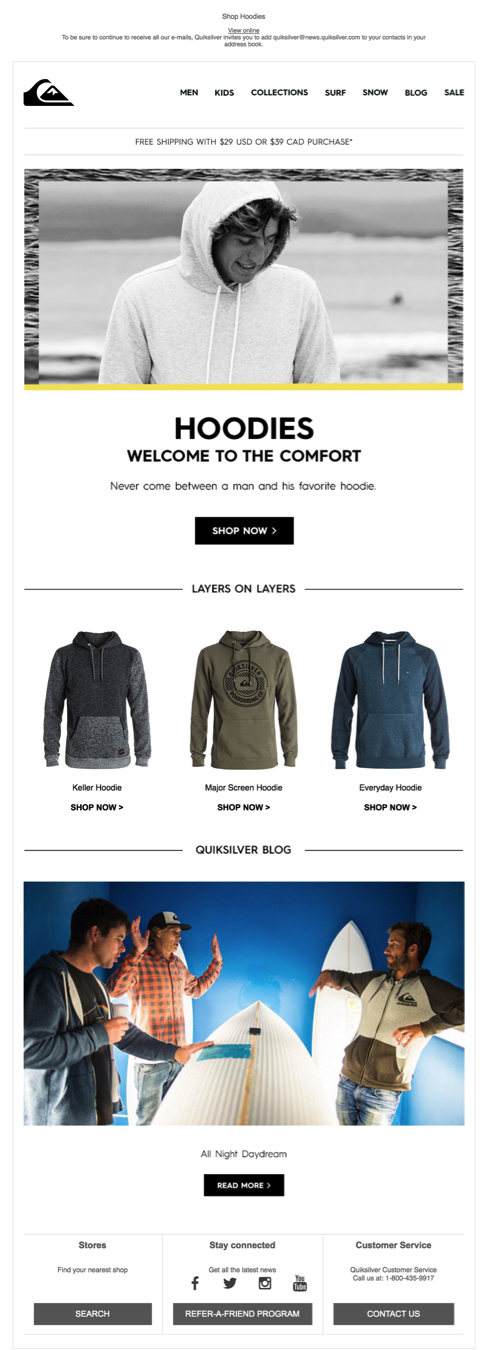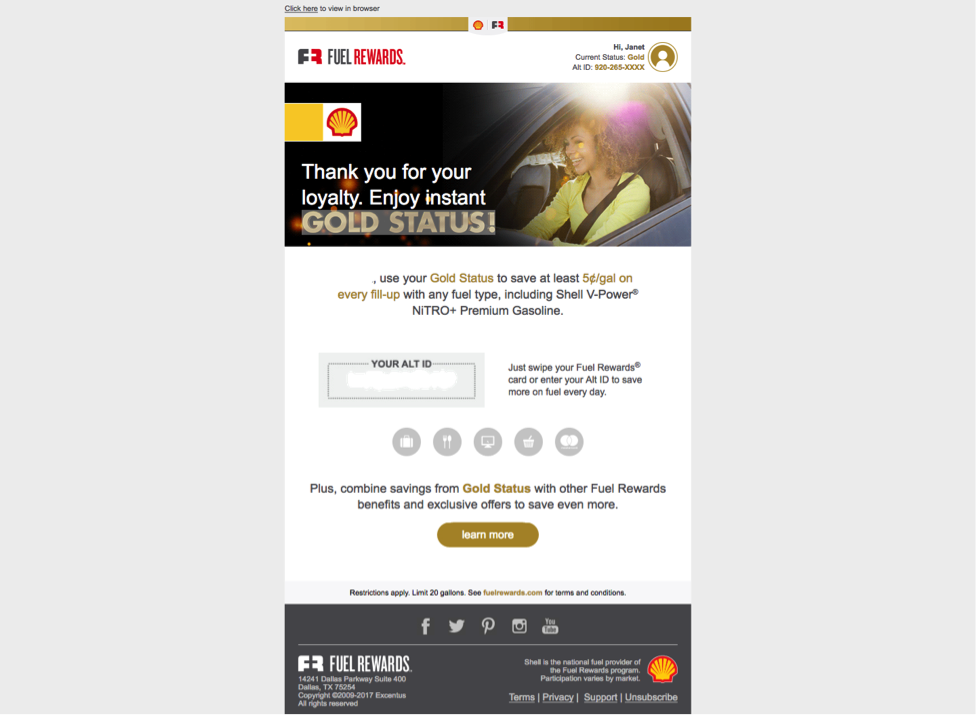Kath Pay: 5 Ecommerce Customer Segments to Automate and Engage with Email
Your customer data is a goldmine of information just waiting to be discovered. You know that emails which reflect a customer's data are more relevant and likely to be acted on, but too many marketers stop at basics like name, gender or location.
Deeper data-mining can unlock insights about your buyers that help solve business problems like these:
- Who are my best customers, and how can I get more of them?
- How can I increase average order value?
- How can I persuade more customers to buy at full price?
- How can I shorten the period to first purchase/conversion?
- How can I bring back more one-time or special-occasion buyers?
With the answers, you can create customer segments that reflect each of these questions and target them with the data you've uncovered.
Where are the answers?
They're lurking in your data. The challenge is finding them.
Your data engineers or CRM people can help. Or, you can work with an agency that's expert at managing data questions like these.
Using data and email to reach 5 often-overlooked customer segments
Even beginners can segment and target, using either preferences or basic behavioral data. To drive more revenue and loyalty, zero in on customers who fall between the cracks of a standard segmentation plan, and target them with emails that reflect their browsing and buying patterns.
Below are five overlooked customer segments, based on the questions that opened this column, that can help you solve major business problems.
- People who browse but never buy
- Where do they come from?
- What identifying data do I have on them? (They might be email subscribers or account-holders.)
- What characteristics do they share?
- How can I convert more of them into first-time purchasers?
- Where are they going on the site, and what pages do they visit most often?
- What do first-time purchasers usually buy?
- Top spenders
- What characteristics do they share?
- Which of these characteristics can I use to increase their number, make them feel appreciated, encourage them to increase their AOV and become brand advocates?
- How did I acquire these customers?
- Which campaigns drive them to act?
- What do they buy most often, and do they buy at full price or with discounts or incentives?
- People who used coupons, discounts and other incentives to buy for the first time.
- What characteristics do they have in common?
- Which incentives do first-time buyers use most often?
- Do incentive users eventually become top shoppers?
- Will a first-time shopper buy again when offered another coupon-incentive?
- People who pay full price the first time they shop.
- What do they have in common?
- What brought them to your site? (Email newsletter, organic search, paid search, social media ad, remarketing ad targeted to browse abandoners, etc.)
- Which products did they buy, and do those products have anything in common?
- How often did they visit your site before purchasing?
- Did they buy at full price at the same time you were running a selected-items sale or promotion?
- Do these shoppers tend to buy at identifiable times of the month (common payday days such as Monday or Friday, beginning or end of the month)?
- Those who buy once during a holiday season but don't return
Who they are
These people wander all over your website, browsing but never buying. They might even go so far as to put items into a basket but never finish checking out.
Questions to ask
Look to your data to learn more about these shoppers and what prevents them from buying or converting (creating accounts, registering for events, etc.).
Ask these questions:
Solve the problem
Offer content. Suppose your tracking metrics show they bounce around your site, often visiting your FAQ page. That means they're researching or uncertain. A downloadable buyers' guide could persuade them to make the leap.
Look for and correct disconnects and other conversion barriers in your page design and processes.
Establish an automated "first purchase" program. This is a series of emails designed to move your shopper from browsing to making that first purchase. If possible, use web analytics to personalize the emails with products or content they viewed on-site.
These emails reflect the shopper's experience without being creepy. Mixing images of products viewed with complementary products or typical first-time purchases can make them think, "Fancy that! I was just looking for something like that!"
Then, move anyone who converts to a "second purchase" program (more on that later).

Using the Pareto Principle, your top spenders likely make up 20% of your database but contribute 80% of your revenue.
If you don't target your messaging, you're relying on chance to make things happen -- they'll come back to your website on their own or maybe see something in a broadcast email that prompts them to act.
Who they are
One way to identify your top spenders is simply by using historical lifetime value. Also, look at order value, frequency and variety. Do they buy the same things over and over, or do they shop other product categories?
How many shoppers to include in this segment depends on your results. If you see a large gap between groups of customers, isolate the top group. Or, identify the top 20 percent of all shoppers.
Questions to ask
Solve the problem
Review your acquisition sources. If you find they're more likely to come from a specific channel, increase its budget.
Set up loyalty programs for the products or categories that your top spenders buy most often. Send personalized emails that promote the program and reflect your shoppers' behavior, budget and buying habits. Include educational or lifestyle content that reinforces and expands their loyalty to those products.
Create a "members only" set of perks and privileges for your top shoppers regardless of product or category preference. Perks can include whatever is most relevant to your brand such as free express shipping: member-only discounts and freebies; advance access to sales and special events; concierge services; handwritten notes from the CEO and rewards for achieving higher spending levels.

The good news: They made their first purchase. The bad news: Your profit margin took a hit. Your task is to approach these new customers carefully and communicate your brand value while making them feel welcome.
Who they are
First-time buyers who used a coupon code from another site, an exit-intent popover on your site, money- or percentage-off discount or incentive (buy one, get one, etc.) to make that first purchase. They could be regular browsers (see No. 1 above) who finally got a deal they couldn't refuse in your regular sales emails.
Questions to ask
Solve the problem
Use unique discount/incentive codes all the way through the buying funnel, combined with exit-intent popovers that appear when the shopper abandons the page.
Example: A shopper browses a specific product or several on a page but does not add anything to a cart. You could offer a discount on the product browsed or a general discount via an exit popover or a targeted follow-up email.
Use a different discount/incentive code at each point in the purchase journey: one code if they abandon the browsed page (top of the funnel), another if they add the item to a cart but abandon before checkout (middle of the funnel) and a third if they abandon during checkout (bottom of the funnel).
The point here is not to toss out discounts at every stop on the customer journey. Rather, use a unique code at each key point on the journey so you can track it and pinpoint where most conversions are coming from.
Test different incentives, such as different percentage discounts, to see if you need a larger discount at the top of the funnel (low intent) than you would at the bottom (high intent).
Measure and track discount/incentive-driven shoppers for lifetime value. Compare them with first-time shoppers who pay full price to see which segment is more valuable. For example, do discount shoppers buy more frequently than full-price shoppers? This could give them a higher lifetime value.
Track discount shoppers for conversion to full-price shopping. See whether they are more or less likely to buy a second time and whether they pay full price that second time. Use this data to make better-informed long-term decisions about discounting and incentives.
Implement a "second purchase" program for these customers, aiming not only to get them not just to buy a second time but to pay full price. Reinforce your USP by using social proof as seen in the example from Fatface.

We love these buyers! But don't ignore them. They can be complex shoppers who might respond to the right kind of automated targeting and email content – or be more likely to take their business elsewhere.
Who they are
Shoppers who pay full price on their first purchases without any incentive or discount.
Questions to ask
Solve the problem
Add a "second purchase" program for this segment, personalized to their behavior and purchases. Stress brand value, other services and benefits they can qualify for when they buy from you, all to encourage a second full-price purchase.

Although these shoppers could qualify for two other customer segments – discount or full-price shoppers – factoring in the holiday season and its pressures and needs complicates the re-engagement picture and sets them apart from these other shopper segments.
Who they are
First-time buyers who shop during holidays – Christmas/Hanukkah/Kwanzaa, Easter, Valentine's Day, Mother's Day – but don't return for follow-up purchases.
Questions to ask
- Did they buy gifts?
- Did they ship the purchase to another person?
- Was the product featured in a gift guide?
- Did the shopper use a gift-suggestion app on your site or request gift wrapping, personalization, etc.?
- Did they check a box indicating the item was a gift?
Solve the problem
Add a covert gift purchase program tied to the holiday. Compare normal and holiday shopping lag times. If the typical lag between first and second purchases is 3 months, put holiday shoppers who have not repurchased within X months (whatever makes sense for your company) into a program that sends automated messages leading up to other gift-giving periods, including the holiday during which they bought.
Note: Be careful when trying to detect gift-ghosters. If your site has gift identifiers (a box indicating a gift, gift-wrapping, etc.), segment shoppers who use them for follow-up messaging. If not, you must follow clues.
However, some shopper habits can throw you off the scent. Many people who send their items to different addresses might be shipping expensive purchases to their offices for safety or convenience.

Getting started
Sit down with your CRM or data people to talk about what you could find out. Or, look into machine learning to focus and automate your messaging to these overlooked customer segments.
Machine learning can be expensive to integrate with your systems, and you need to be sure that the algorithms you use are producing the messages you want to send. (That's why humans will always have to be part of the marketing equation!) But manually identifying these segments and programs is a good baby step that can help you move toward a truly data-driven future.

 How to resolve AdBlock issue?
How to resolve AdBlock issue? 